Related Research Articles

The Khmer Empire or Angkor Empire are the terms that historians use to refer to Cambodia from the 9th century to the 15th century when the nation was a Hindu/Buddhist empire in Southeast Asia. The empire referred to itself as Kambuja or Kambujadesa which were ancient terms for Cambodia. The empire grew out of the former civilizations of Funan and Chenla, at times ruled over and/or vassalised most of mainland Southeast Asia and parts of Southern China, stretching from the tip of the Indochinese Peninsula northward to modern Yunnan province, China, and from Vietnam westward to Myanmar.

Srivijaya was a Buddhist thalassocratic empire based on the island of Sumatra, Indonesia, which influenced much of Southeast Asia. Srivijaya was an important centre for the expansion of Buddhism from the 8th to the 12th century AD. Srivijaya was the first unified kingdom to dominate much of the Malay Archipelago. The rise of the Srivijayan Empire was parallel to the end of the Malay sea-faring period. Due to its location, this once-powerful state developed complex technology utilizing maritime resources. In addition, its economy became progressively reliant on the booming trade in the region, thus transforming it into a prestige goods-based economy.

Vima Kadphises, was a Kushan emperor from approximately 90–100 CE. According to the Rabatak inscription, he was the son of Vima Takto and the father of Kanishka.

Vima Takto or Vima Taktu was a Kushan emperor who reigned c. 80–90 CE.

Vāsudeva I was a Kushan emperor, last of the "Great Kushans." Named inscriptions dating from year 64 to 98 of Kanishka's era suggest his reign extended from at least 191 to 232 CE. He ruled in northern India and central asia and still minted in coins in Balkh (Bactria) as well, although he probably had to deal with the rise of the Sasanians and the first incursions of the Kushano-Sasanians in the northwest of his territory.
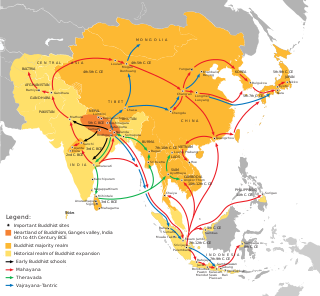
Buddhism entered Han China via the Silk Road, beginning in the 1st or 2nd century CE. The first documented translation efforts by Buddhist monks in China were in the 2nd century CE via the Kushan Empire into the Chinese territory bordering the Tarim Basin under Kanishka. These contacts transmitted strands of Sarvastivadan and Tamrashatiya Buddhism throughout the Eastern world.

The Shailendra dynasty was the name of a notable Indianised dynasty that emerged in 8th-century Java, whose reign signified a cultural renaissance in the region. The Shailendras were active promoters of Mahayana Buddhism with the glimpses of Hinduism, and covered the Kedu Plain of Central Java with Buddhist monuments, one of which is the colossal stupa of Borobudur, now a UNESCO World Heritage Site.

Greater India, or the Indian cultural sphere is an area composed of many countries and regions in South, East and Southeast Asia that were historically influenced by Indian culture. The term Greater India as a reference to the Indian cultural sphere was popularised by a network of Bengali scholars in the 1920s. It is an umbrella term encompassing the Indian subcontinent, and surrounding countries which are culturally linked or have received significant Sanskritisation and Indian influence in matters such as written language and religion. These countries have been transformed to varying degrees by the acceptance and induction of cultural and institutional elements that originated in India and spread elsewhere via trade routes. Since around 500 BCE, Asia's expanding land and maritime trade had resulted in prolonged socio-economic and cultural stimulation and diffusion of Hindu and Buddhist beliefs into the region's cosmology, in particular in Southeast Asia and Sri Lanka. In Central Asia, transmission of ideas were predominantly of a religious nature. The spread of Islam significantly altered the course of the history of Greater India.
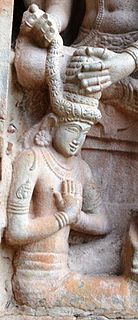
Rajendra Chola I or Rajendra I was a Tamil Chola emperor of South India who succeeded his father Rajaraja Chola I to the throne in 1014 CE. During his reign, he extended the influence of the Chola empire to the banks of the river Ganga in North India and across the Indian ocean to the West and South East Asia, making the Chola Empire one of the most powerful maritime empires of India. Rajendra's conquests included Sri Lanka, Maldives, and he successfully invaded the territories of Srivijaya in Malay Peninsula, Southern Thailand, Sumatra and Java in South East Asia. The Cholas exacted tribute from Thailand and the Khmer kingdom of Cambodia. He defeated Mahipala, the Pala king of Gauda in present-day Bengal and Bihar, and to commemorate his victory he assumed the title of 'Gangaikondachola', literally the Chola who conquered the Ganga and also built a new capital city called Gangaikonda Cholapuram
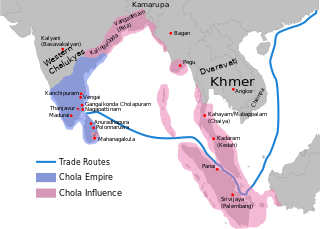
The Chola dynasty was a Tamil thalassocratic empire of southern India, one of the longest-ruling dynasties in the world's history. The earliest datable references to the Chola are in inscriptions from the 3rd century BCE left by Ashoka, of the Maurya Empire. As one of the Three Crowned Kings of Tamilakam, along with the Chera and Pandya, the dynasty continued to govern over varying territory until the 13th century CE. Despite these ancient origins, the period when it is appropriate to speak of a "Chola Empire" only begins with the medieval Cholas in the mid-9th century CE.
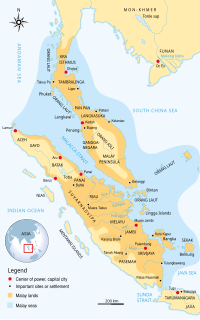
The Melayu Kingdom was a classical Malay Buddhist kingdom located in Southeast Asia.

Balaputradewa was the maharaja of Srivijaya in the 9th century CE as well as the former head of the Sailendra dynasty. He was the youngest son of the preceding Sailendran maharaja, Samaratunga, through marriage with Dewi Tara who was in turn the daughter of another maharaja, Dharmasetu of Srivijaya.
Zabag is thought to have been an ancient kingdom located south of China somewhere in Southeast Asia, between the Chenla Kingdom and Java. The established studies by several historians associated this kingdom with Srivijaya and thought its location was somewhere in Sumatra, Java or Malay Peninsula. Indonesian historian suggested that Zabag is connected to the present day Muara Sabak area, the estuarine of Batang Hari River in East Tanjung Jabung Regency, Jambi province. Zabag may also located in Java, not Srivijaya because Zabag is noted to annex Srivijaya, and the size of Zabag is only half the size of an island called Ramni (Sumatra).

Southeast Asia was under Indian sphere of cultural influence starting around 290 BC until around the 15th century, when Hindu-Buddhist influence was absorbed by local politics. Kingdoms in the southeast coast of the Indian Subcontinent had established trade, cultural and political relations with Southeast Asian kingdoms in Burma, Thailand, Indonesia, Malay Peninsula, Philippines, Cambodia and Champa. This led to Indianisation and Sanskritisation of Southeast Asia within Indosphere, Southeast Asian polities were the Indianised Hindu-Buddhist Mandala.

In 1025, Rajendra Chola I, the Chola king from Tamil Nadu in South India, launched naval raids on the city-state of Srivijaya in maritime Southeast Asia, Rajendra's overseas expedition against Srivijaya was a unique event in India's history and its otherwise peaceful relations with the states of Southeast Asia. Several places in present day Malaysia and Indonesia were invaded by Rajendra Chola I of the Chola dynasty. The Chola invasion furthered the expansion of Tamil merchant associations such as the Manigramam, Ayyavole and Ainnurruvar into Southeast Asia. The Chola invasion led to the fall of the Sailendra Dynasty of Srivijaya and the Chola invasion also coincides with return voyage of the great Buddhist scholar Atiśa from Sumatra to India and Tibet in 1025. The expedition of Rajendra Chola I is mentioned in the corrupted form as Raja Chulan in the medieval Malay chronicle Sejarah Melayu, and Malay princes have names ending with Cholan or Chulan, such as Raja Chulan of Perak.

Yijing, formerly romanized as I-ching or I-tsing, was a Tang-era Chinese Buddhist monk famed as a traveller and translator. His account of his travels is an important source for the history of the medieval kingdoms along the sea route between China and India, especially Srivijaya in Indonesia. A student of the Buddhist university at Nālandā, he was also responsible for the translation of many Buddhist texts from Sanskrit and Pali into Chinese.
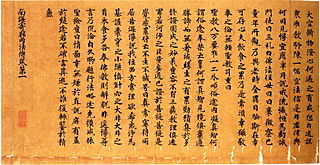
A Record of Buddhist Practices Sent Home from the Southern Sea, also known as the Nanhai Jigui Neifa Zhuan and by other translations, is a Buddhist travelogue by the Tang Chinese monk Yijing detailing his twenty five-year stay in India and Srivijaya between the years 671 and 695 CE.
Sri Maravijayottunggavarman was a king of Srivijaya Kingdom of Sailendra dynasty, who reigned between 1008-c.1025 CE. He was the son of King Sri Chudamanivarmadeva. He was called Se-li-ma-la-pi in the Chinese chronicle.
Rudra Vikrama was an 8th-century king of Srivijaya Kingdom who sent two emissaries to China, first one in 728 CE and the second one in 742 CE. His name was recorded in the chronicle New Book of Tang as Liu-t'eng-wei-kung, and his royal title was Ho-mi-to which could be the Sanskrit word Amrta ("immortal").
Sri Deva was a king of Srivijaya Kingdom of Sailendra dynasty, who in 1028 CE sent an envoy to China. In the chronicle History of Song, his name was recorded as Shih-li Tieh-hua, which may not to be his complete title. He ruled shortly after Srivijaya's various territories were attacked by King Rajendra I of the Chola dynasty in 1025 CE, in which King Sangramavijayottunggawarman of Srivijaya was defeated and captured by his opponent. Chola attack was not accompanied by the occupation of the Srivijaya territories.
References
- 1 2 3 4 Azra, Azyumardi (2006). Islam in the Indonesian World: An Account of Institutional Formation. Mizan Pustaka. pp. 155–158. ISBN 9789794334300.
- 1 2 Journal of the Greater India Society. The Society. 1956. p. 73.
- ↑ Slatyer, Will (2014). Ebbs and Flows of Medieval Empires, AD 900?1400. Partridge India. pp. 140–141. ISBN 9781482896831.
- ↑ Tōyō Bunko, (Japan) (1972). Memoirs of the Research Department. p. 5.
| | This biography of a member of an Asian royal house is a stub. You can help Wikipedia by expanding it. |